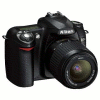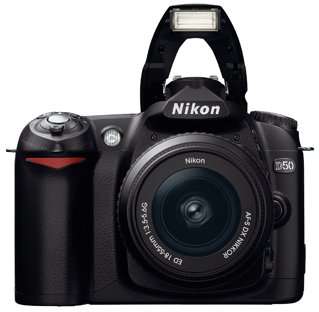- Qualcomm Launches Snapdragon 4 Gen 2 Mobile Platform
- AMD Launches Ryzen PRO 7000 Series Mobile & Desktop Platform
- Intel Launches Sleek Single-Slot Arc Pro A60 Workstation Graphics Card
- NVIDIA Announces Latest Ada Lovelace Additions: GeForce RTX 4060 Ti & RTX 4060
- Maxon Redshift With AMD Radeon GPU Rendering Support Now Available
Nikon D50 6.1MP Digital-SLR Camera

If you are looking to get into the D-SLR world but find it too expensive, then you may not know the value that awaits you. We are taking a look at the Nikon D50 6.1 megapixel camera, and given the pricerange, it packs a serious punch.
Page 2 – Closer Look
|
|
The D50 is equipped with a DX CDD that allows for 6.1 Megapixel images. This equates to final images of 3,008 * 2,000 (1.504:1 Ratio). As I mentioned, this is a camera designed for a beginner shooter, which means the camera is not complicated to learn if you have never touched an SLR before. Using the Auto setting, you can take some pretty amazing pictures quickly.
The Auto mode will analyze your scene and adjusts the white balance, color and ISO for you. Once you feel more confident, or don’t need the Auto for a particular shot, you can move onto full manual control. In all honesty though, if you are a beginner and just enjoy snapping photos more for fun than professionalism, you may never need to switch off of the Auto mode unless you wish to do close-ups. Most of the images I have had this mode churn out have been quite nice. Few have needed any real PP (post processing).
Here is Nikons stance on the camera:
- New 6.1 effective megapixel Nikon DX Format CCD imaging sensor produces 3,008 x 2,000-pixel images with accurate colour, high resolution and sharp details for great pictures; print as enlargements or crop for creative effect.
- Advanced digital image processor produces optimized image quality, including auto white balance, auto tone and colour control; real-time processes diminish digital noise to produce beautiful long exposure shots. Images are ready to print straight from the camera.
- 3D Color Matrix Metering II ensures accurate exposure control and white balance.
- Seven Digital Vari-Program selections automatically optimize ISO- equivalent sensitivity, white balance, sharpening, tone (contrast), colour, saturation and hue for crisp and vivid results; selections include Auto, Portrait, Landscape, Child, Sports, Close up, and Night Portrait.
- Near-instant 0.2-second power-up, and short shutter release time lag, plus continuous shooting at 2.5 frames per second for a continuous burst of up to 137 pictures, will have you shooting like a pro.
- New large 2.0-inch LCD monitor located directly below the viewfinder displays the large fonts of the new easy-to-view, easy-to-understand menu design, and the dialogs of the intuitive new help system.
- Long-life rechargeable lithium-ion battery has power to shoot up to 2,000 images on a single charge.
2,000 images on a single charge may sound like an exaggeration, but I believe it could easily happen if you use a low quality setting. In my tests, I have been able to take over 900 RAW+JPEG images before a recharge. That also included a few formats and picture viewing… normal usage.

One benefit of Digital SLRs is the RAW picture format. Essentially, this is a lossless version of the photo that you can deal with later. However, RAW is not a format you want to deal with lightly, because each photo will take an upwards of 6MB. That said, RAW is not for normal uses… and you would not be using it in a slideshow. So, RAW+JPEG essentially saves the image both as a RAW file, .NEF in Nikon’s case, and also a JPEG. I have one gripe with this though…
… In total, there are three main JPEG modes… Basic, Normal and Fine, the latter being the crispest quality available. If you wish to use RAW+JPEG then JPEG is actually Basic quality. There is no way to change it to… RAW+JPEG Fine for example. Though, this may also be a benefit. RAW+JPEG Fine would take longer to save to the camera. However, if you want the best quality photos available, you would have to manually save the .NEF file as a high-quality JPEG when you get back to your PC. Regardless of how long RAW+JPEG Fine would actually take to save, an option would have been nice.
Before we move onto a physical look at the camera, you may wish to review all of the official specs.
- Type of Camera – Single-lens reflex digital camera
- Effective Pixels – 6.1 million
- Image Sensor – RGB CCD, 23.7 x 15.6mm; total pixels: 6.24 million
- Image Size (pixels) – 3,008 x 2,000 [L], 2,256 x 1,496 [M], 1,504 x 1,000 [S]
- Sensitivity – 200 to 1600 (ISO equivalent) in steps of 1 EV
- Storage Media – SD Memory Card
- Storage System – Compressed NEF (RAW): 12-bit compression, JPEG: JPEG baseline-compliant
- File System – Exif 2.21, Compliant DCF 2.0 and DPOF
- (Number of frames per 256MB SD Memory card, image size L)
- RAW approx. 33, FINE approx. 70
- NORMAL approx. 137
- BASIC approx. 258, RAW & BASIC approx. 29
- White Balance – Auto (TTL white balance with 420-pixel RGB sensor), six manual modes, preset white balance, white balance bracketing possible
- LCD Monitor – 2.0-in., 130,000-dot, low-temperature polysilicon TFT LCD with brightness adjustment
- Playback Function – 1 frame: Thumbnail (4 or 9 segments); Magnifying playback; Slide show; Histogram indication; Highlight point display; Auto image rotation
- Delete Function – Card format, All frames delete, Selected frames delete
- Video Output – Can be selected from NTSC and PAL
- Interface – USB 2.0 (Hi-Speed)
- Text Input – Up to 36 characters of alphanumeric text input available with LCD monitor and multi-selector; stored in Exif header
- 1) DX Nikkor: All functions supported 2) Type G or D AF Nikkor: All functions supported 3) Micro Nikkor 85 mm F2.8D: All functions supported except autofocus and some exposure modes 4) Other AF Nikkor: All functions supported except 3D Color Matrix Metering II 5) AI-P Nikkor : All functions supported except 3D Color Matrix Metering II and autofocus 6) Non-CPU : Can be used in exposure mode M, but exposure meter does not function; electronic range finder can be used if maximum aperture is f/5.6 or faster
- Note: IX Nikkor lenses can not be used
- Picture Angle – Equivalent in 35mm [135] format is approx. 1.5 times lens focal length
- Viewfinder – Fixed eye-level penta-Dach-mirror type; built-in diopter adjustment (-1.6 to +0.5m-1)
- Eyepoint – 18mm (-1.0m-1)
- Focusing Screen – Type-B BriteView Clear Matte screen Mark V with superimposed focus brackets
- Viewfinder Frame Coverage – Approx. 95%
- Viewfinder Magnification – Approx. 0.75x with 50mm lens at infinity; -1.0m-1
- Viewfinder Information – Focus indications, AE/FV lock indicator, Shutter speed, Aperture value, Exposure/Exposure compensation indicator, Flash output level compensation, Exposure compensation, Number of remaining exposures, Flash ready indicator
- Autofocus – TTL phase detection by Nikon Multi-CAM900 autofocus module with AF-assist illuminator (approx. 0.5m to 3.0m) Detection range: EV -1 to +19 (ISO 100 equivalent, at normal temperature: 20�C)
- Lens Servo – 1) Autofocus (AF-A): Auto-Servo AF; camera automatically chooses single-servo AF (AF-S) or continuous servo AF (AF-C); predictive focus tracking automatically activated according to subject status 2) AF-S 3) AF-C 4) Manual focus (M)
- Focus Area – Can be selected from 5 focus areas
- AF Area Mode – 1) Single Area AF, 2) Dynamic Area AF, 3) Closest Subject Priority Dynamic Area AF
- Focus Lock – Focus can be locked by pressing shutter-release button halfway (single-servo AF) or by pressing AE-L/AF-L button
- Exposure Metering System – TTL full-aperture exposure metering system (1) 3D Color Matrix Metering II with 420-pixel RGB sensor (2) Center-weighted: Weight of 75% (8mm dia. circle) (3) Spot: Meters 3.5mm dia. circle (about 2.5% of frame) centered on active focus area
- Exposure Metering Range – 1) EV 0 to 20 (3D Color Matrix or center-weighted metering) 2) EV 2 to 20 (spot metering) (ISO 100 equivalent, f/1.4 lens, 20�C)
- Exposure Modes – Digital Vari-Program (Auto, Portrait, Landscape, Child, Sports, Close up, Night portrait), Programmed Auto [P] with flexible program; Shutter-Priority Auto [S]; Aperture Priority Auto [A]; Manual [M]
- Exposure Compensation – �5 EV in increments of 1/3 or 1/2 EV
- Auto Exposure Lock – Luminosity locked at detected value with AE-L/AF-L button
- Auto Exposure Bracketing – Three frames �2 EV in 1/3 or 1/2 steps
- Shooting Modes – 1) Single frame shooting mode 2) Continuous shooting mode: approx. 2.5 frames per second 3) Self-timer mode 4) Delayed remote mode: 2 sec. delay 5) Quick�response remote mode
- Shutter – Combined mechanical and CCD electronic shutter, 30 to 1/4000 sec. in steps of 1/3 or 1/2 EV, bulb
- Sync Contact – X-contact only; flash synchronization at up to 1/500 sec. Flash Control 1) TTL: TTL flash control by 420-pixel RGB sensor Built-in Speedlight: i-TTL Balanced Fill-Flash or standard i-TTL flash (spot metering) SB-800 or 600: i-TTL Balanced Fill-Flash or standard i-TTL flash (spot metering) 2) Auto aperture: Available with SB-800 with CPU lens 3) Non-TTL Auto: Available with Speedlights such as SB-800, 80DX, 28DX, 28, 27, and 22s 4) Distance-priority manual available with SB-800
- Flash Sync Mode – 1) Front-curtain Sync (normal sync), 2) Red-eye Reduction, 3) Red-eye Reduction with Slow Sync, 4) Slow Sync, 5) Rear-curtain Sync
- Built-in Speedlight – Auto, Portrait, Child, Close-up, Night portrait: auto flash with auto pop-up [P], [S], [A], [M]: manual pop-up with button release Guide number (ISO 200/ISO 100, m): approx. 15/11 (manual full 17/12)
- Flash Compensation – -3 to +1 EV in increments of 1/3 or 1/2 EV
- Accessory Shoe – Standard ISO hot-shoe contact with safety lock provided
- Self-timer – Electronically controlled timer of 2 to 20 seconds duration
- Remote Control – Wireless Remote Controller ML-L3 (optional)
- Power Source – One Rechargeable Li-ion Battery EN-EL3, AC Adapter EH-5 (optional)
- Tripod Socket – 1/4 in. (ISO1222)
- Dimensions (W x H x D) – Approx. 133 x 102 x 76mm
- Weight – Approx. 540g without battery, memory card, or body cap
- Supplied Accessories* – Rechargeable Li-ion Battery EN-EL3, Quick Charger MH-18a, Video Cable, USB Cable UC-E4, Strap, Body cap, Eyepiece Cap DK-5, Rubber Eyecup DK-20, Accessory shoe cover, PictureProject CD-ROM
- Optional Accessories – Rechargeable Li-ion Battery EN-EL3, Multi Charger MH-19, Quick Charger MH-18a, AC Adapter EH-5, Speedlight SB-800/600, Eyepiece Magnifier DG-2, Angle Finder DR-6, Nikon Capture 4 (Ver.4.3) Software, Wireless Remote Control ML-L3, Semi-Soft Case CF-D50
- Storage
- Compatible Lenses
Ok, that’s out of the way. Let’s take a quick look at the various buttons around the camera.
|
|
Support our efforts! With ad revenue at an all-time low for written websites, we're relying more than ever on reader support to help us continue putting so much effort into this type of content. You can support us by becoming a Patron, or by using our Amazon shopping affiliate links listed through our articles. Thanks for your support!





